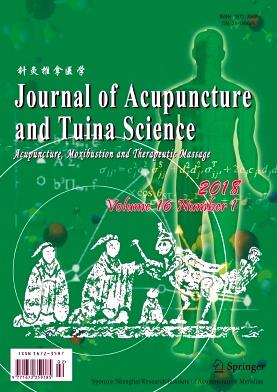大推天河水对内毒素性发热幼兔的解热作用机制研究
IF 0.5
4区 医学
Q4 INTEGRATIVE & COMPLEMENTARY MEDICINE
引用次数: 0
Abstract
Abstract Objective To observe the effect of large pushing Tianheshui manipulation intervention on the body temperature of young rabbits with endotoxin-induced fever and discuss its antipyretic mechanism. Methods Thirty-two young rabbits meeting the standards were selected from 40 ordinary young male New Zealand rabbits after being adapted for 7 d, and randomly divided into a normal group, a model group, a large pushing Tianheshui group, and an ibuprofen group according to the random number table method, with 8 rabbits in each group. Rabbits in the model group, the large pushing Tianheshui group, and the ibuprofen group were subjected to preparing the endotoxin-induced fever model by intravenous lipopolysaccharide from the marginal ear vein. Rabbits in the large pushing Tianheshui group received Tuina (Chinese therapeutic massage) manipulation intervention 1.5 h and 2.5 h after modeling, respectively. Rabbits in the ibuprofen group were intragastrically given ibuprofen suspension 1.5 h after modeling. The dynamic changes in body temperature were observed for the young rabbits after fever modeling. Enzyme-linked immunosorbent assay was used to determine the content changes in positive mediators of hypothalamic body temperature, including prostaglandin (PG) E 2 and cyclic adenosine monophosphate (cAMP), as well as negative mediators of hypothalamic body temperature, including arginine vasopressin (AVP) and α-melanocyte stimulating hormone (α-MSH). Results The body temperature of the young rabbits in the model group was significantly higher than that in the normal group at 0.5–4.0 h, 5.0 h, and 5.5 h after modeling ( P <0.01), showing two obvious fever peaks in the model group at 1.5 h and 3.0 h after modeling, respectively, with the highest peak at 1.5 h. Compared with the model group, body temperatures of the large pushing Tianheshui group and the ibuprofen group decreased significantly after 0.5 h of intervention ( P <0.05). Compared with the normal group, the contents of PGE 2 and cAMP were significantly increased ( P <0.05), and the contents of AVP and α-MSH were significantly decreased ( P <0.01) in the hypothalamus of the model group. Compared with the model group, the contents of PGE 2 and cAMP were significantly decreased ( P <0.01), and the levels of AVP and a-MSH were significantly increased ( P <0.01) in the hypothalamus in the large pushing Tianheshui group and the ibuprofen group. There were no significant differences in the PGE 2 , cAMP, AVP, and α-MSH contents in the hypothalamus between the ibuprofen group and the large pushing Tianheshui group ( P >0.05). Conclusion Large pushing Tianheshui manipulation has a significant antipyretic effect on endotoxin-induced fever in young rabbits. The mechanism may be related to inhibiting the positive regulators (PGE 2 and cAMP) and promoting the negative regulators (AVP and α-MSH) of hypothalamic control of body temperature.大推天河水对内毒素性发热幼兔的解热作用机制研究
【摘要】目的观察大推天合水手法干预对内毒素致发热幼兔体温的影响,并探讨其解热机制。方法从40只普通雄性新西兰兔幼兔中选取适应7 d后符合标准的幼兔32只,按随机数字表法随机分为正常组、模型组、大推天合水组和布洛芬组,每组8只。模型组、大推天合水组、布洛芬组家兔经耳缘静脉滴注脂多糖制备内毒素致热模型。大推天合水组分别在造模后1.5 h和2.5 h进行推拿手法干预。布洛芬组在造模后1.5 h ig布洛芬混悬液。观察发热造模后幼兔体温的动态变化。采用酶联免疫吸附法测定下丘脑体温阳性介质前列腺素(PG) e2、环磷酸腺苷(cAMP)含量变化,下丘脑体温阴性介质精氨酸抗利尿素(AVP)、α-促黑素(α-MSH)含量变化。结果体温的小兔子模型组显著高于正常组在0.5 - -4.0 h, h, 5.0和5.5 h建模(P & lt; 0.01),显示模型组的两个明显的热峰值为1.5 h和3.0 h建模后,分别与最高峰1.5 h。与模型组相比,大推Tianheshui组的体温和布洛芬组显著降低0.5 h后干预(P & lt; 0.05)。与正常组比较,模型组下丘脑pge2、cAMP含量显著升高(P <0.05), AVP、α-MSH含量显著降低(P <0.01)。与模型组比较,大推天合水组和布洛芬组大鼠下丘脑pge2、cAMP含量显著降低(P <0.01), AVP、a-MSH水平显著升高(P <0.01)。布洛芬组与大推天河水组大鼠下丘脑pge2、cAMP、AVP、α-MSH含量差异无统计学意义(P >0.05)。结论大推天合水手法对内毒素致幼兔发热有明显的解热作用。其机制可能与抑制下丘脑体温控制的正调节因子(pge2和cAMP)和促进负调节因子(AVP和α-MSH)有关。
本文章由计算机程序翻译,如有差异,请以英文原文为准。
求助全文
约1分钟内获得全文
求助全文
来源期刊

Journal of Acupuncture and Tuina Science
INTEGRATIVE & COMPLEMENTARY MEDICINE-
CiteScore
0.60
自引率
40.00%
发文量
55
期刊介绍:
Journal of Acupuncture and Tuina Science (ISSN 1672-3597, CN 31-1908/R) is a journal with an international scope, focusing on the popularization of traditional Chinese medicine and acupuncture- moxibustion culture, the promotion of international exchanges and the prosperity of clinical Chinese medicine and acupuncture-moxibustion. Journal of Acupuncture and Tuina Science mainly involves clinical practice and emphasizes the presentation of the detailed methods of observing and treating clinical common diseases on which acupuncture-moxibustion has a good effect. The articles are characterized by practicality, briefness and reproducibility. The main contents include the experiences of senior TCM doctors, forum on special diseases, clinical reports, brief reports, education series, terminology and brief introduction to new books. Communications regarding Academy activities are also appropriate.
 求助内容:
求助内容: 应助结果提醒方式:
应助结果提醒方式:


